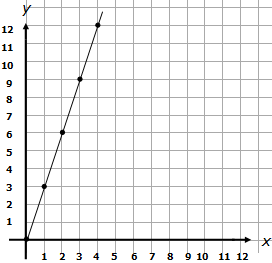Choose from the list below where to jump to, depending on your mathematical background
[Under construction]
What is slope?
On a graph, we talk about the vertical part of it as the "Y" and the horizontal as the "X"

It is measured by HOW MUCH change in the Y, per change of 1 in the X.
If you put that ramp on the graph,
Which is 6m long (along the horizontal, the X axis) and 2m tall (y axis),
Then what is the mathematical slope of it?
Answer: 2 / 6 = 1/3
2m of Y per 6m of X, right? that is: 2y per 6x or 1 y per 3 x.
Slope = 1/3 Y per 1 X
That is, for each step in the X axis, the line moves up by about 0.333 on the Y axis.
Just remember: How much Y per 1 X; How much vertical per 1 step in the horizontal
The slope from rates of changes
How do we get "how much Y" per "1 of X"?
Let's say we have a road that is 4 meters long.
Thus, on the picture below, each block is 1 meter of the road.
There are 3 stones per every meter, as shown:
Key: The amount of stones per meter is consistently 3, otherwise the graph wouldn't have a straight line.
Key: Since distance is independent of the stones, we call it the independent variable. Since how many stones we've passed depends on the distance covered, we call it the dependent variable.
As such, we will ALWAYS have the independent variable plotted on the X axis.
It will always be a linear increase and what's on the X determines the value of the Y!
We would then plot "amount of stones collected" on the Y axis and "meters of road covered" on the X axis.
Look at this Y (Stones) and X (Distance) table:
Using the "rise over run" idea, if you're familiar with it, what is the slope?
-----Yes, the same as above as you might've expected--------
What you are doing is just what we covered above.
We could measure the rate of change of anything in respect to anything else, not just stones in respect to distance!
We can say that each stone (the red circles) are instead just representing 1 litre of water (think of each red ball as a 1L bottle of water!)
We can then say that each block is representing 1 second instead of 1 meter.
What we'd then have is 3L/second of water flowing into something!
Instead of water we could say meters. Then, we'd be moving at: 3 meters every 1 second, or our speed = 1 m/s
So, as you move across the blocks:
For the first example: How many stones you've passed through
2nd eg: How many litres of water you collected
3rd: How many meters of distance you covered
Next step:
You might start with some amount of stone already. Let's say you already have 10 stones with you before you enter that road.
Let's plot on the Y of the graph "how many stones you have". If we write that mathematically:
Stones you have = (how many stones you started off with) + (stones/meter) * meters covered
Or for water:
Total water (at some time) = initial water + flow*(that time)
T = i + F*t
If we plot Total water per time on an X vs Y plane,
Y= water at time X
Since we start with some initial "i", then before the time starts, at 0 seconds, x=0, then the graph has to start at that point on the Y axis. We call that the "Y intercept
If we started with 3 Liters of water:
Remind you of an equation?
m = rate of change or rate of gain of something.
rise / run can be written as:
dy / dx
dy = difference in the y
dx, same story.
Negative slope
What if you start with 10 Liters of water in your bottle, and at every hour you drink 1 litre.
After 10 hours, you drank 10 litres.
Questions
A) Y = 5x + 0
B) Y = x + 10
C) Y= 4
D) Y = -x + 10
For each equation,
If X =0, Y=
Slope=_____
Y-intercept = ____Initial amount (what we start with) =____
if X stops at 10 (at X=10). Final amount = __________
Note that in that 3rd example, Y does not change at all with respect to X. It's always just 4, so it looks like a straight line:
Applying it to Physics
First, definitions of some letters:D = Distance (usually in meters)
T = Time (usually in seconds)
V= Velocity = Speed (The rate of change of distance, thus in meters/second, [m/s] )
A = acceleration (The rate of change of speed, thus [m/s] / s or m/S2)
J = Jerk (The rate of change of acceleration, thus [[m/s]/s] /s or m/S3)
f = Final
i = Initial
Df = Di + v*t << 1st difference
Vf = Vi + a*t << 2nd difference (of change in distance)
Af = Ai + j*t << 3rd
Let's say that each block represents 1 second. Inside each block is the speed (=the velocity) at that second:
We start with 0, which means we aren't moving at all.
In the 1st second, we're at 2 m/s
| 0 | 2 | 4 | 6 |
At the end of the 3rd second, we're at 6 m/s
Now let's say we start off already moving at a constant speed of 10 m/s
| 10 | 12 | 14 | 16 |
Questions
What is our acceleration? __________
What is the Y-intercept for the 2nd example? ________
What velocity do we start off with? _____





